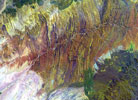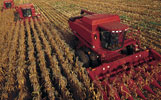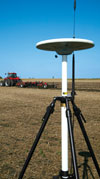
NASA has been working hand in glove with agricultural organisations and farmers in the USA since the 1999 launch of its Ag20/20 programme – an industry-government partnership led by NASA and the United States Department of Agriculture (USDA).
Landsat 7 was launched in 1999 and data from Landsat-related research has led, amongst other benefits, to improved water management techniques. In July 2007 Ball Aerospace was selected to supply the LDCM OLI (Landsat data continuity mission operational land imager) which is specified to provide pixel ground sampling distances of between 14 and 30 m, depending on spectral band.
This is just one of many examples of the growing use of technology in agriculture and farming.

Drivers for technology introduction
Key drivers for the introduction of technology in agriculture are lack of labour, high employment costs, reduced fertility of soils, the need to raise yields, regulatory requirements relating to traceability and green considerations. The latter include the desire to reduce the usage of pest and disease control chemicals, and to reduce the use of chemical fertilisers.
Technologies
As well as satellite imagery and GPS (global positioning systems), other technologies that are being employed down on the farm include aerial thermal imaging, visual spectrum and near infra red (NIR) imaging, image recognition, autonomous vehicles, robotics and wireless instrument networks.

Precision farming
Precision farming uses technologies like global positioning and geographic information systems (GIS) to gather and process large amounts of data which can be analysed to inform farm management decisions. In NASA’s words it is 'Knowing and caring where you are in a field'.
As well as optimising yield, precision farming aims to achieve yield uniformity across the planted area.
Using aerial and land-based observations it is possible to identify areas of a field that require more nitrogen, pH adjustment, organic matter, water or treatments for pests. This information is then entered into a GIS and the data loaded on an on-vehicle computer. As the tractor traverses the field individual precision spray nozzles, linked to the computer on a CAN network, are controlled to only treat the necessary areas, or fertilisers are accurately dosed to treat only those areas low in nutrients, based on the GIS mapped information and the actual position of the tractor as determined by GPS.
In a similar way irrigation can be controlled so that moisture levels are maintained optimally and overwatering is avoided.
As an indication of the savings achieved, one farmer’s experience indicated that precision application has cut nitrogen use at his farm by 30 to 40% and pesticide use by 20%.
Data on the move
An important aspect of precision farming is that of feedback in the form of yield. For this method of farming to be effective farmers need to know which parts of a field deliver higher and lower yields – not just data for the field as a whole. This has led to the wide-scale use of yield monitors. According to the Manitoba Agricultural department there are over 17 000 of these instruments in use in North America. They are mounted on harvesters to provide data on yield per area, wet and dry measures of yield, moisture content and other relevant measurements. The data are recorded on the move with GPS coordinates to become input for geographical information systems. This then becomes input for subsequent precision field fertiliser application.
One of the drawbacks of precision agriculture is this need to know so much data about the multiple locations (GPS coordinates) on a field grid. Considerable effort is being put into systems that provide soil analysis on the move, rather than relying on workers with handheld PDAs and GPSs to take and record soil sample data. On-the-move soil samplers use various electrochemical, electromagnetic, mechanical, optical and radiometric principles to determine soil condition.
Buses on tractors
ISO 11783, aka ISOBUS, is a communication protocol for the agriculture industry and is based on the SAE (Society of Automotive Engineers) J1939 protocol, which also includes CAN. The ISOBUS definition takes into consideration the nature of agricultural equipment and considers at least two bus segments. The first of these is the Tractor bus segment which provides for intercommunication on the tractor between powertrain, valves and other on-tractor located devices. The second is the Implement bus segment which provides connectivity between tractor and implement and between devices on the implement. At least one Tractor Electronic Control Unit (ECU) is required for communication between the two segments.
Autonomous vehicles
There is a growing trend toward the development and use of autonomous vehicles in agriculture – from irrigation machines to complete tractors. Researchers at Hokkaido University in Japan developed an autonomous guidance system that controlled a tractor for row-following and end-of-row turning making it possible to perform all field activities without human intervention. The system uses CAN as the on-board control network. They also developed a variable rate planter which performs site-specific fertiliser application and a variable rate sprayer, both of which connect to the CAN network.

Combining standard GPS with correction signals from realtime kinematic (RTK) base station networks it is possible to achieve centimetre resolution of position. Adoption of RTK was initially slow because of the costs involved, but more recently large organisations have established their own RTK networks and offer rental use of the service. Trimble Ag in the USA says that between 2005 and 2006, the number of acres covered by RTK networks more than doubled and the company estimates that RTK base station networks cover more than 120 million acres of US farmland.

High tech irrigation
Technology employed in irrigation systems includes autonomous irrigation machines, soil moisture sensors, soil and air temperature sensors, wireless instrument networks, weather stations and thermal imaging of crop canopy.
Researchers at the US Department of Agriculture, Agricultural Research Service have been developing in-field wireless sensors using low cost wireless radios for sampling instrument signals at 10 s frequency. These signals are used to update a base station which then sends control data to the irrigation machine.
As the irrigation machine traverses the field under the control of GPS and GIS its on-board PLC adjusts the water delivered by multiple mid level and low level precision spray nozzles based on inputs from the base station.
At Potlatch Corporation’s Hybrid Poplar Agroforestry Project in Oregon a scada system controls 170 pumps as part of an irrigation system that covers what is claimed to be the largest contiguous drip-irrigated tree farm. The scada communicates with 153 field processors via spread-spectrum radio telemetry to ultimately feed over 17 million emitters.
Farmer Rob has good vision
There are many applications, over and above autonomous vehicles, for robotics in agriculture: one particular area is in harvesting fruit in hydroponic and commercial greenhouse installations. Robotic harvesting of vine-grown produce like tomatoes and cucumbers requires a high degree of robotic dexterity driven by vision recognition technology.
The vision systems on such harvesters need to be able to identify produce that is partially hidden by leaves and stems, and is of the correct ripeness and size. Once a ripe fruit is identified the robot needs to be able to pluck it without damage to the fruit and to the vine – even if a stem is between the robot and its target.
In a robotic tomato harvesting project supported by a research grant from NASA John F. Kennedy Space Center success rates of over 95% for tomato fruit sensing and 85% for picking were achieved.
A project for using a camera vision system and a seven-degrees-of-freedom manipulator for cucumber harvesting undertaken at Wageningen University and Research Centre managed to harvest 74% of the cucumbers present. Researchers at Wageningen have also been working on robotic weeders capable of both inter-row and intra-row weeding.
Swarm robots
The Agricultural and Biological Engineering Department of the University of Illinois is active in the development of low cost harvesting and other agricultural robots and has posited the concept of the AgAnt – an autonomous weeding robot that traverses fields on the lookout for weeds. When an AgAnt finds a patch it calls on other AgAnts to help it eradicate the weeds. It has also been suggested that the weeds could become the energy source for such robots.
About the author
Andrew Ashton has electrical, mechanical and business qualifications and has been active in automation and process control since the early 1980s. Since 1991 he has headed up a company that has developed formulation management systems for the food, pharmaceutical and chemical manufacturing industries and manufacturing solutions involving the integration of various communication technologies and databases. Developed systems address issues around traceability, systems integration, manufacturing efficiency and effectiveness. Andrew is features editor for SA Instrumentation and Control and editor of Motion Control in Southern Africa.
| Tel: | +27 11 543 5800 |
| Email: | [email protected] |
| www: | www.technews.co.za |
| Articles: | More information and articles about Technews Publishing (SA Instrumentation & Control) |

© Technews Publishing (Pty) Ltd | All Rights Reserved